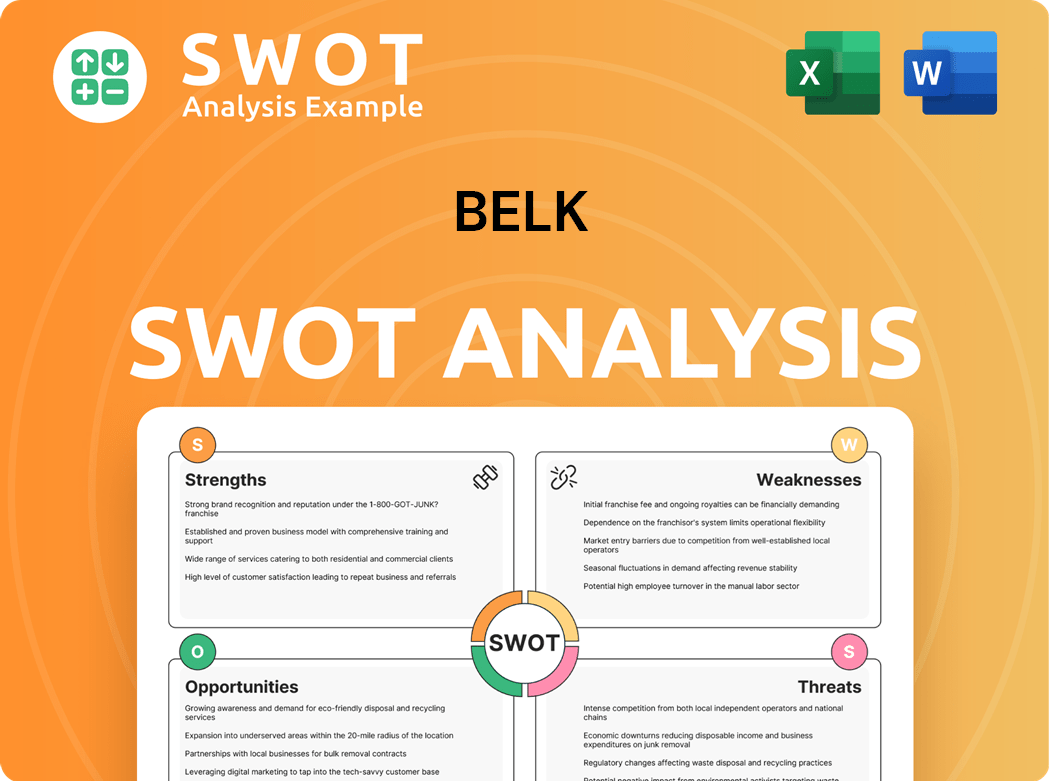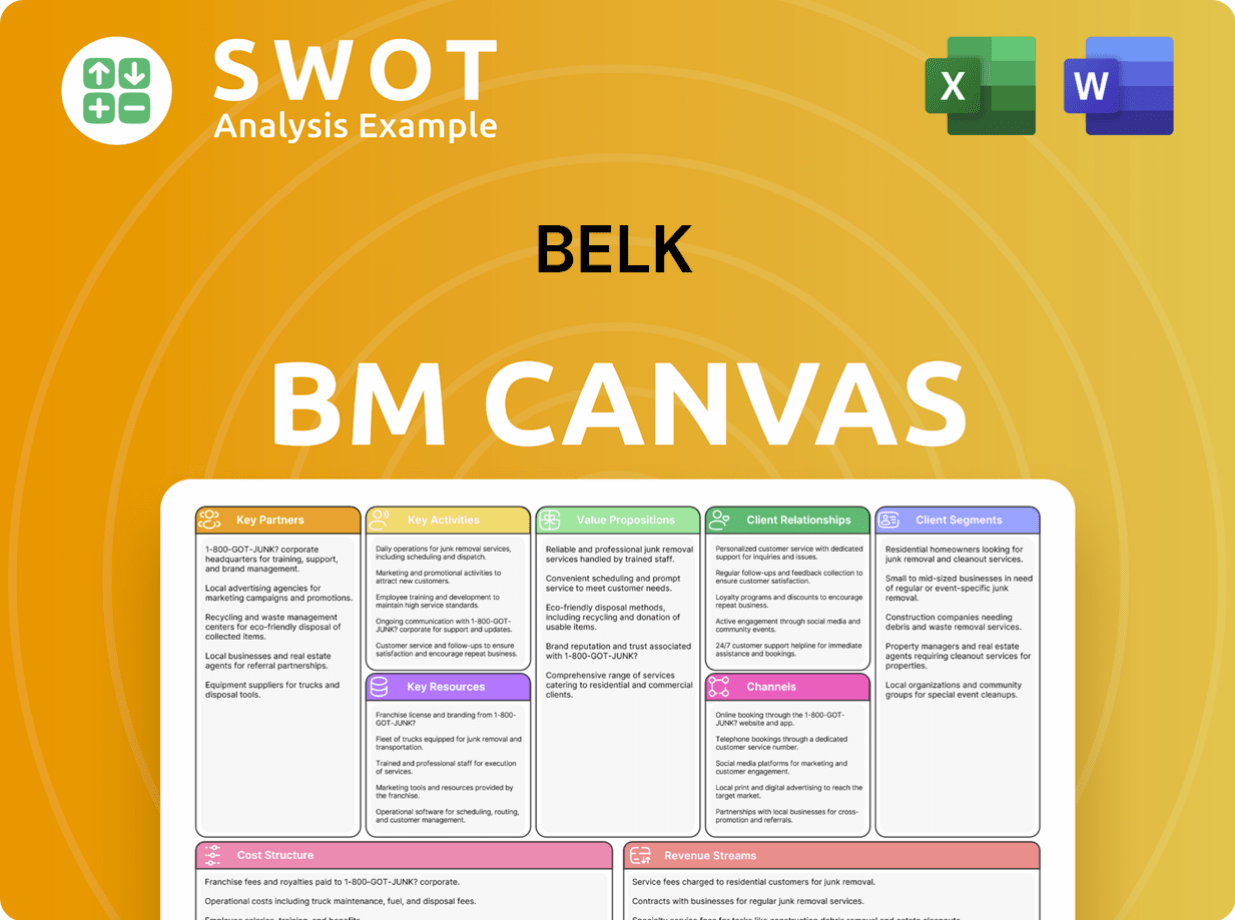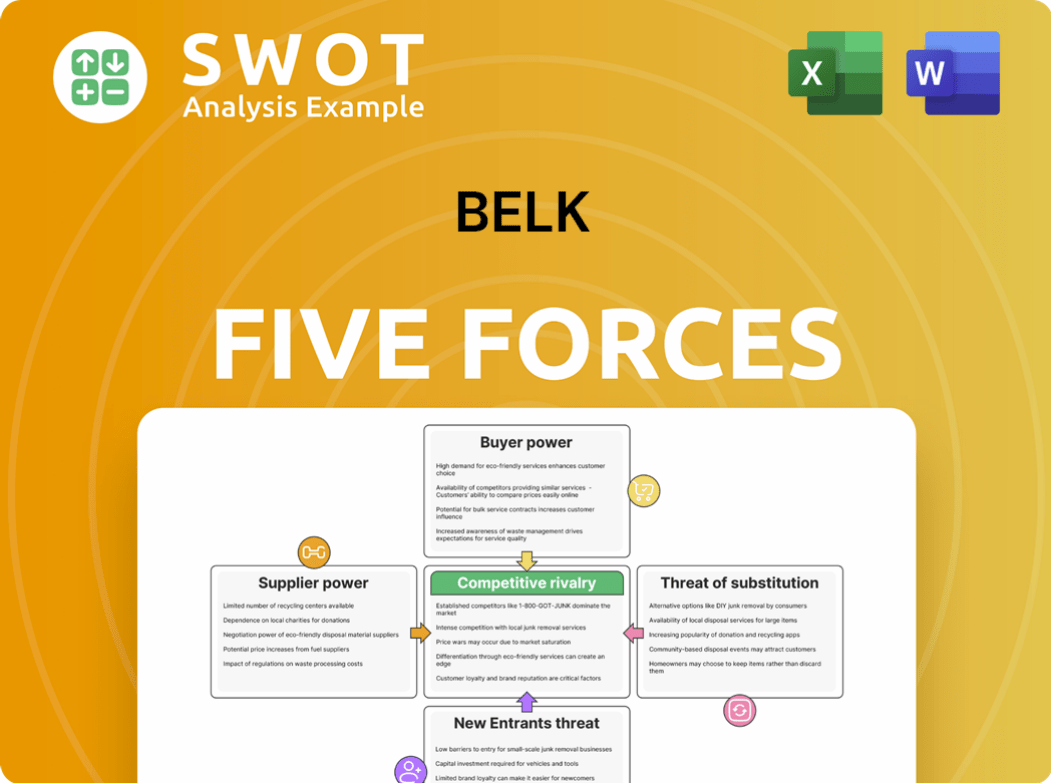Belk Bundle
Can Belk Thrive in Today's Retail Arena?
The department store industry is a battlefield, constantly reshaped by consumer demands and digital innovation. Belk, a Southern retail icon, has weathered over a century of change, but the fight for market share is fiercer than ever. Understanding the Belk SWOT Analysis is crucial to understanding its position.

This analysis dives deep into the Belk competitive landscape, examining its rivals and strategic positioning. We'll explore the Belk company overview, dissecting its strengths and weaknesses within the department store industry. Furthermore, we'll conduct a thorough Belk market analysis to understand how it navigates the intense retail competition and maintains its relevance.
Where Does Belk’ Stand in the Current Market?
Belk primarily operates within the competitive mid-tier department store segment, focusing on the Southern United States. Understanding the Belk competitive landscape is crucial for assessing its market position. While specific, up-to-date market share figures for privately held companies like Belk are often not publicly disclosed, industry analysis consistently places them as a significant regional player.
Their core operations revolve around offering a broad range of merchandise. This includes national and private-label apparel for men, women, and children, shoes, accessories, cosmetics, and home furnishings. The company's value proposition centers on providing a convenient shopping experience with a focus on customer service and a curated selection of products tailored to Southern consumers.
Geographically, Belk's presence is concentrated in states like North Carolina, South Carolina, Georgia, Florida, and Texas, where they have a long-established brand presence and customer loyalty. This regional focus allows Belk to better understand and cater to the specific preferences of its target demographic. To learn more, you can explore the Revenue Streams & Business Model of Belk.
Belk's market share is significant within the Southern US, though precise figures are not always public. Their strong regional presence provides a distinct advantage in understanding and catering to the preferences of its Southern customer base. This targeted approach helps them compete effectively.
Belk offers a wide array of products, including apparel, shoes, accessories, cosmetics, and home furnishings. They carry both national brands and private-label items, catering to diverse customer needs. This broad selection helps them attract a wide customer base.
Belk has adapted its positioning to respond to market shifts. The company has invested heavily in its digital transformation, expanding its e-commerce capabilities to meet the growing demand for online shopping. This reflects a broader industry trend.
While specific recent financial figures are not available, the broader department store sector has faced headwinds. Belk's strategic initiatives, including store remodels and supply chain improvements, aim to bolster its financial performance. These initiatives are key to maintaining their competitive standing.
Belk's success hinges on several key factors that differentiate it from competitors. These include its strong regional presence, its omnichannel approach, and its focus on customer service.
- Regional Focus: Deep understanding of Southern consumer preferences.
- Omnichannel Strategy: Integration of online and in-store shopping experiences.
- Customer Service: Emphasis on providing a positive shopping experience.
- Product Selection: Wide range of merchandise including national and private labels.
Belk SWOT Analysis
- Complete SWOT Breakdown
- Fully Customizable
- Editable in Excel & Word
- Professional Formatting
- Investor-Ready Format

Who Are the Main Competitors Challenging Belk?
The Belk competitive landscape is shaped by a diverse range of rivals, both direct and indirect, operating within the retail sector. Understanding these competitors is crucial for analyzing Belk's market position and developing effective strategies. This analysis considers both traditional department stores and emerging retail formats that impact Belk's performance.
A comprehensive Belk market analysis reveals the complexities of the retail environment. The company faces pressure from various fronts, including established department stores, off-price retailers, online giants, and specialty stores. Each competitor brings unique strengths and strategies, influencing Belk's approach to product offerings, pricing, and customer engagement.
Belk's ability to adapt and innovate is critical for maintaining its competitive edge. This involves continuous assessment of the competitive landscape and the implementation of strategies to meet the evolving demands of consumers. The following sections delve into the key competitors and their impact on Belk.
Macy's, Dillard's, and Kohl's are Belk's primary direct competitors in the department store industry. These retailers compete for the same customer base, offering similar product categories like apparel, home goods, and beauty products.
Macy's operates nationally with a vast brand portfolio. It competes directly with Belk in apparel, home goods, and beauty, often utilizing promotional pricing and loyalty programs to attract customers. In 2024, Macy's reported net sales of approximately $23.1 billion.
Dillard's has a strong presence in the Southern and Southwestern United States, mirroring Belk's regional focus. It targets a similar demographic with fashion and home merchandise. Dillard's reported net sales of around $6.3 billion in 2024.
Kohl's is known for its value-oriented approach and private-label brands. It competes with Belk in apparel and home categories, using its Kohl's Cash rewards program. Kohl's generated approximately $17.9 billion in net sales in 2024.
Belk also faces indirect competition from off-price retailers, online retailers, and specialty stores. These competitors offer different value propositions, impacting Belk's market share.
TJ Maxx, Marshalls, and Ross Stores provide significant price advantages on branded merchandise. These retailers attract budget-conscious consumers. TJX Companies, the parent company of TJ Maxx and Marshalls, reported net sales of about $54.2 billion in fiscal year 2024.
Amazon and Shein present a formidable challenge with vast selections, competitive pricing, and efficient delivery. Amazon's net sales in 2024 were approximately $574.8 billion in North America.
Specialty apparel retailers like Old Navy and American Eagle Outfitters, as well as home goods retailers such as HomeGoods and At Home, compete for specific customer segments. Old Navy's 2024 sales were about $8 billion.
Belk must continuously adapt to the evolving retail landscape. This includes addressing pricing strategies, product offerings, and customer engagement. The rise of fast fashion and direct-to-consumer (DTC) brands further fragments the market.
- Pricing Strategies: Belk needs to balance competitive pricing with maintaining profitability.
- Product Offerings: Regularly updating merchandise to meet current trends and customer preferences.
- Customer Engagement: Enhancing loyalty programs and improving the online shopping experience.
- Market Trends: Adapting to the growth of online shopping and changing consumer preferences.
Belk PESTLE Analysis
- Covers All 6 PESTLE Categories
- No Research Needed – Save Hours of Work
- Built by Experts, Trusted by Consultants
- Instant Download, Ready to Use
- 100% Editable, Fully Customizable

What Gives Belk a Competitive Edge Over Its Rivals?
The competitive advantages of the company stem from a blend of its historical presence, regional focus, and ongoing strategic adjustments. The company has cultivated strong brand recognition and customer loyalty, particularly in the Southern United States, over its more than a century of operations. This long-standing presence allows the company to understand and cater to the specific preferences of its regional customer base, fostering repeat business. Further, the company has invested in its omnichannel strategy, integrating its brick-and-mortar stores with its e-commerce platform.
The company also leverages its private-label brands, offering exclusive merchandise at competitive price points, differentiating itself from national brands carried by competitors. These private labels often cater directly to the aesthetic and practical needs of its core Southern consumer. Additionally, the company's long-standing relationships with vendors and its supply chain network, refined over decades, contribute to operational efficiencies and product availability. While not always at the scale of national giants, the company's localized distribution can sometimes enable quicker replenishment and better inventory management for regional trends. The company's commitment to community engagement and personalized customer service in its physical stores also serves as a differentiator, fostering a more intimate shopping experience compared to larger, more impersonal national chains.
These advantages, while facing threats from the broader retail shifts, are continuously refined through marketing, product development, and strategic partnerships to maintain their relevance. The company's ability to adapt and innovate is crucial in the dynamic department store industry. For more information on the company's ownership, you can read about the Owners & Shareholders of Belk.
The company benefits from strong brand recognition and customer loyalty, especially in the Southern United States. This established presence allows the company to understand and cater to the specific preferences of its regional customer base, fostering repeat business. This deep-rooted connection helps the company maintain a competitive edge in the retail competition.
The company has invested in an omnichannel strategy, seamlessly integrating its brick-and-mortar stores with its e-commerce platform. This allows customers the flexibility to shop online and pick up in-store, or browse in-store and have items shipped, enhancing the overall shopping experience. This integrated approach is crucial for competing in the modern retail environment.
The company leverages its private-label brands, which offer exclusive merchandise at competitive price points, providing differentiation from national brands carried by competitors. These private labels often cater directly to the aesthetic and practical needs of its core Southern consumer. This strategy helps the company maintain a unique selling proposition.
The company's long-standing relationships with vendors and its supply chain network, refined over decades, contribute to operational efficiencies and product availability. While not always at the scale of national giants, the company's localized distribution can sometimes enable quicker replenishment and better inventory management for regional trends. This operational efficiency is a key factor in the Belk competitive landscape.
The company differentiates itself through its strong brand recognition, omnichannel strategy, private-label brands, and efficient supply chain. These elements contribute to a unique customer experience and operational advantages. The company’s commitment to community engagement and personalized customer service in its physical stores also serves as a differentiator, fostering a more intimate shopping experience compared to larger, more impersonal national chains.
- Strong regional presence and customer loyalty.
- Integrated omnichannel approach for a seamless shopping experience.
- Exclusive private-label brands offering competitive pricing.
- Efficient supply chain and vendor relationships.
Belk Business Model Canvas
- Complete 9-Block Business Model Canvas
- Effortlessly Communicate Your Business Strategy
- Investor-Ready BMC Format
- 100% Editable and Customizable
- Clear and Structured Layout

What Industry Trends Are Reshaping Belk’s Competitive Landscape?
The retail landscape is in constant flux, demanding that department stores like Belk continually adapt to maintain their competitive edge. A comprehensive Belk competitive landscape analysis reveals a sector shaped by rapid technological advancements, shifting consumer preferences, and intense competition. Understanding the Belk market analysis is crucial for navigating these complexities and identifying opportunities for growth.
The department store industry faces numerous challenges, including the rise of e-commerce, changing consumer demands, and economic uncertainties. Retailers must strategically position themselves to thrive. This involves adapting to digital transformation, focusing on customer experience, and optimizing operational efficiency. The future outlook for Belk depends on its ability to navigate these challenges and capitalize on emerging opportunities.
E-commerce continues to dominate, with online sales accounting for a significant portion of total retail sales. Sustainability and ethical sourcing are increasingly important to consumers. Personalized shopping experiences are becoming a standard expectation. Retailers must invest in technology and adapt their supply chains to meet these demands.
Maintaining profitability amidst rising operational costs and economic pressures is a major hurdle. Intense competition from both online and brick-and-mortar retailers requires continuous innovation. Adapting to changing consumer behaviors and preferences. Keeping up with rapid technological advancements.
Leveraging a strong physical footprint by enhancing omnichannel capabilities like buy online, pick up in-store (BOPIS). Expanding private-label offerings to cater to specific customer preferences. Forming strategic partnerships to reach new markets or offer innovative products. Capitalizing on regional strengths by tailoring product assortments and marketing efforts.
Investing in technology, such as AI-powered personalization and data analytics, is essential. Focusing on customer experience through personalized services and loyalty programs. Prioritizing sustainability and ethical sourcing to meet consumer demands. Building a flexible supply chain that can quickly respond to changes in demand.
To succeed, Belk must focus on its core strengths while adapting to the evolving retail environment. A crucial aspect is understanding its target market. For further insights into this, explore the Target Market of Belk. This will enable the company to tailor its strategies effectively.
- Enhance Omnichannel Capabilities: Improve online and in-store integration.
- Personalize Customer Experience: Use data to offer tailored shopping experiences.
- Focus on Sustainability: Offer eco-friendly products and practices.
- Strategic Partnerships: Collaborate with brands and tech providers.
Belk Porter's Five Forces Analysis
- Covers All 5 Competitive Forces in Detail
- Structured for Consultants, Students, and Founders
- 100% Editable in Microsoft Word & Excel
- Instant Digital Download – Use Immediately
- Compatible with Mac & PC – Fully Unlocked

Related Blogs
- What are Mission Vision & Core Values of Belk Company?
- What is Growth Strategy and Future Prospects of Belk Company?
- How Does Belk Company Work?
- What is Sales and Marketing Strategy of Belk Company?
- What is Brief History of Belk Company?
- Who Owns Belk Company?
- What is Customer Demographics and Target Market of Belk Company?
Disclaimer
All information, articles, and product details provided on this website are for general informational and educational purposes only. We do not claim any ownership over, nor do we intend to infringe upon, any trademarks, copyrights, logos, brand names, or other intellectual property mentioned or depicted on this site. Such intellectual property remains the property of its respective owners, and any references here are made solely for identification or informational purposes, without implying any affiliation, endorsement, or partnership.
We make no representations or warranties, express or implied, regarding the accuracy, completeness, or suitability of any content or products presented. Nothing on this website should be construed as legal, tax, investment, financial, medical, or other professional advice. In addition, no part of this site—including articles or product references—constitutes a solicitation, recommendation, endorsement, advertisement, or offer to buy or sell any securities, franchises, or other financial instruments, particularly in jurisdictions where such activity would be unlawful.
All content is of a general nature and may not address the specific circumstances of any individual or entity. It is not a substitute for professional advice or services. Any actions you take based on the information provided here are strictly at your own risk. You accept full responsibility for any decisions or outcomes arising from your use of this website and agree to release us from any liability in connection with your use of, or reliance upon, the content or products found herein.